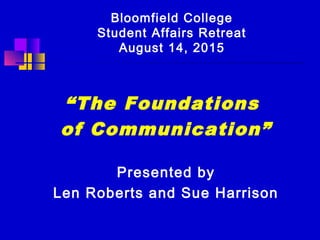
LISTENING.PPT_Student Affairs Retreat Aug 2015
- 1. “The Foundations of Communication” Presented by Len Roberts and Sue Harrison Bloomfield College Student Affairs Retreat August 14, 2015
- 2. Our Goals for This Session Discuss Some Issues that Occur with Miscommunication Discuss How Individuals Communicate with Each Other Practice Our Skills to Increase Our Ability to Communicate More Clearly
- 3. Listening “Seek first to understand… Then to be understood.” -- Dr. Stephen Covey The Seven Habits of Highly Effective People
- 4. Skit “Order Two Sandwiches from Charlie’s Sub Shop”
- 5. Skit Discussion What are some of your observations about the Skit? What was and what was not communicated?
- 6. The Three Levels of Communication Item Activity Percentage 1 Vocabulary 7 % 2 Voice Inflections 38 % 3 Nonverbal Behavior 55 % 100% From Peter R. Garber in 50 Communications Activities, Icebreakers, and Exercises
- 7. Listening & Communication Exercise “I know that you believe you understand…”
- 8. Listening & Communication Exercise “I know that you believe you understand what you think I said, but I am not sure you realize that what you heard is not what I meant!” Quote from a U.S. Government Official
- 9. Listening How Many Levels of Listening are There?
- 10. Listening There are Seven Levels of Listening! From Peter R. Garber In 50 Communications Activities, Icebreakers, and Exercises
- 11. Level 1 Listening Not Listening: Not paying attention to or ignoring the other person’s communications.
- 12. Level 2 Listening Pretend Listening: Acting like or giving the impression that you are paying attention to another person’s communications, but in actuality not really paying attention to that individual.
- 13. Level 3 Listening Partially Listening: Only focusing on part of the other person’s communication or only giving it your divided attention.
- 14. Level 4 Listening Focused Listening: Giving the other person your undivided attention to his or her communication.
- 15. Level 5 Listening Interpretive Listening: Going beyond just paying attention but really trying to understand what the other person is communicating.
- 16. Level 6 Listening Interactive listening: Being involved in the communications by asking clarifying questions or acknowledging understanding of the communication.
- 17. Level 7 Listening Engaged listening: Being fully engaged in communications involves listening to the other person’s views, feelings, interpretations, values, etc., concerning the communication and sharing yours as well with the other person(s). In engaged listening, both parties are given the opportunity to fully express their views, feelings, and ideas.
- 18. Reasons for Poor Listening Hearing problems Physical noise Effort: listening is hard; it is not natural Message overload Rapid thought Psychological noise Faulty assumptions Cultural differences